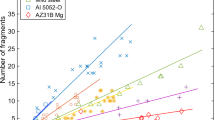Abstract
A model has been proposed to estimate the average number of fragments produced by ductile fracture of a rapidly expanding ring with arbitrary cross-section. The model uses a minimum number of constants characterizing the material properties of the ring. We assume that material of the ring is incompressible with the density ρ and its mechanical behavior obeys the ideal rigid-plastic model with yield stress Y. It is shown that the average number of fragments weakly depends on the cross-sectional shape, if characteristic size of the cross-section does not change. The results obtained by the model are compared with the experiments of Grady and Benson (Exp Mech 23:393–400, 1983) where the aluminum and copper rings were tested. The comparison shows good agreement with the experiments with the copper rings over the entire range of strain rates realized in these experiments. For the aluminum rings, such agreement is observed only for high strain rates.


Similar content being viewed by others
References
Richert J, Wagner P (2001) Microscopic model approaches to fragmentation of nuclei and phase transitions in nuclear matter. Phys Rep 350:1–92
Hartmann WK (1969) Terrestrial, lunar, and interplanetary rock fragmentation. Icarus 10:201–213
Oddeshede L, Dimon P, Bohr J (1993) Self-organized criticality in fragmenting. Phys Rev Lett 71:3107
Timar G, Kun F, Carmona HA, Herrmann HJ (2012) Scaling law for impact fragmentation of spherical solids. Phys Rev E 86:016113
Zhang H, Ravi-Chandar K (2010) On the dynamics of localization and fragmentation—IV Expantion of AL 6061-0 tubes. Int J Fract 163:41–65
Mott NF (1947) Fragmentation of shell cases. Proc R Soc A189:300–308
Grady DE (2006) Fragmentation of rings and shells. Springer, Berlin
Goloveshkin VA, Myagkov NN (2014) Fragmentation model for expanding cylinder. Int J Fract 187:239–243
Gerasimov AV, Dobritsa DB, Pashkov SV et al (2016) Theoretical and experimental study of a method for the protection of spacecraft from high–speed particles. Cosmic Res 54:118. https://doi.org/10.1134/S0010952516020015
Myagkov NN, Shumikhin TA, Bezrukov LN (2010) Experimental and numerical study of peculiarities at high-velocity interaction between a projectile and discrete bumpers. Int J Impact Eng 37:980–994
Moxnes JF, Børve S (2005) Simulation of natural fragmentation of rings cut from warheads. Def Technol 11:319–329
Myagkov N, Bezrukov L, Shumikhin T (2009) Experimental investigation of ejecta generated by the hypervelocity impact of aluminum projectiles on continuous and mesh bumper. In: Proceeding of fifth European conference on space debris. ESOC, Darmstadt, Germany
Grady DE, Benson DA (1983) Fragmentation of metal rings by electromagnetic loading. Exp Mech 23:393–400
Acknowledgements
The work was carried out within the framework of the government task (Registration Number AAAA-A19-119012290136-7).
Author information
Authors and Affiliations
Corresponding author
Ethics declarations
Conflict of interest
The authors declare that they have no conflict of interest.
Additional information
Publisher's Note
Springer Nature remains neutral with regard to jurisdictional claims in published maps and institutional affiliations.
Rights and permissions
About this article
Cite this article
Goloveshkin, V.A., Myagkov, N.N. Fragmentation model of a rapidly expanding ring with arbitrary cross-section. Meccanica 54, 1219–1224 (2019). https://doi.org/10.1007/s11012-019-01017-z
Received:
Accepted:
Published:
Issue Date:
DOI: https://doi.org/10.1007/s11012-019-01017-z




